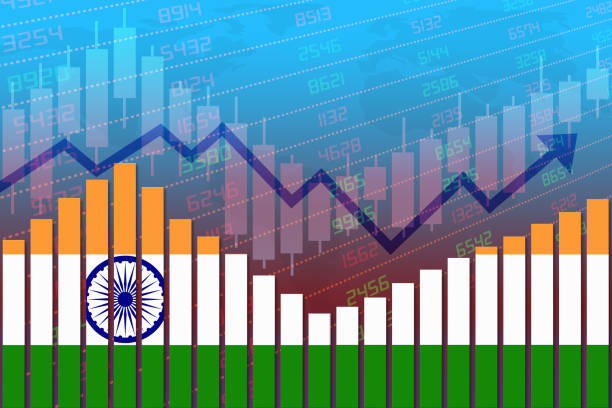“Understanding the Indian Economy: A Look at GDP, Inflation, and the Services Sector”
The Indian economy is one of the fastest growing in the world, with a GDP growth rate of around 7% in recent years. However, despite this strong growth, the country still faces a number of economic challenges, including high inflation and a large trade deficit.
One of the key drivers of the Indian economy is the services sector, which accounts for around 55% of GDP. This includes industries such as finance, IT, and tourism, and has been a major contributor to the country’s economic growth.
However, the Indian economy also faces a number of challenges, including a high inflation rate, which has been above 6% for the past several years. This has led to rising costs for consumers and businesses, and has made it more difficult for the government to control the economy.
In addition to inflation, the Indian economy also has a large trade deficit, which means that it imports more goods and services than it exports. This has led to a decline in the value of the rupee and has made it more difficult for Indian businesses to compete globally.
Despite these challenges, the Indian economy is expected to continue growing in the coming years, thanks in part to government efforts to improve infrastructure and encourage foreign investment.
“The Impact of Demonetization on the Indian Economy”
In November 2016, the Indian government announced that it would demonetize 500 and 1000 rupee notes, effectively removing 86% of the currency in circulation. The move was intended to reduce corruption and curb the use of black money, but it had a significant impact on the Indian economy.
As people rushed to deposit their old notes and exchange them for new ones, there was a shortage of cash, leading to long lines at banks and ATMs. This caused a slowdown in economic activity, particularly in the informal sector, which relies heavily on cash transactions.
The demonetization also led to a decline in consumer spending and a slowdown in GDP growth. In the immediate aftermath of the move, GDP growth dropped from 7.9% in Q3 2016 to 6.1% in Q4 2016.
However, in the long run, demonetization is expected to have a positive impact on the Indian economy. The move has increased the number of bank accounts and digital transactions, promoting financial inclusion and making it easier for the government to track transactions and reduce corruption.
“India’s Agricultural Sector: Challenges and Opportunities”
Agriculture is a vital sector of the Indian economy, providing livelihoods for around 50% of the country’s population. However, the sector faces a number of challenges, including low productivity, limited access to technology, and climate change.
One of the biggest challenges facing India’s agricultural sector is low productivity. Despite being one of the world’s largest producers of crops like rice, wheat, and sugarcane, India’s yields are significantly lower than those of other major agricultural countries.
Another major challenge is limited access to technology. Many farmers in India still use traditional methods of farming, which are less efficient and less productive than modern techniques. This makes it difficult for them to compete with farmers in other countries.
Climate change also poses a significant threat to the agricultural sector in India, with increasing temperatures and changing rainfall patterns affecting crop yields.
Despite these challenges, the Indian government has taken steps to support the agricultural sector, including investing in research and development, providing subsidies, and launching programs to promote the adoption of modern farming techniques.
In recent years, there have also been some success stories, like organic farming, contract farming, agro-tourism, rural enterprises,
About the impact of GST on Indian economy
The Goods and Services Tax (GST) is a comprehensive indirect tax system that was implemented in India in 2017. The GST replaced a variety of indirect taxes, such as VAT, excise duty, and service tax, and aimed to simplify the tax system and reduce the tax burden on businesses.
One of the main benefits of GST is that it has reduced the cascading effect of taxes, also known as “tax on tax”. Under the previous system, businesses had to pay taxes on inputs, such as raw materials, and then pay additional taxes on the finished goods or services. This added to the cost of doing business and made it more difficult for businesses to compete. GST eliminates this cascading effect by allowing businesses to claim input tax credit for taxes paid on inputs.
Another benefit of GST is that it has increased the compliance of small and medium-sized enterprises (SMEs). Under the previous system, many SMEs were not registered for taxes, and thus, not paying taxes. GST has made it easier for SMEs to register and comply with taxes, increasing their formalization and making it easier for the government to track and collect taxes.
However, GST has also had some negative impacts on the Indian economy. One of the main concerns is that it has increased the tax burden on consumers, particularly for goods and services that were previously taxed at a lower rate. In addition, the GST system has been criticized for its complexity, with multiple rates and frequent changes, which has made it difficult for businesses to comply with the new system.
Overall, while GST has brought many benefits to the Indian economy, it has also caused some disruptions and challenges. The Indian government is continuously working on the improvement and simplification of the GST system to make it more efficient and business-friendly in future.
“The Impact of Digitalization on the Indian Economy”
The digital revolution has had a significant impact on the Indian economy in recent years. The government’s Digital India initiative, launched in 2015, has aimed to increase digital literacy and access to technology, as well as promote digital transactions and e-governance.
One of the main benefits of digitalization is that it has increased financial inclusion, particularly in rural areas. Digital payments and banking have made it easier for people to access financial services, even in remote areas where traditional banking services may not be available.
Digitalization has also led to an increase in productivity and efficiency. E-commerce, for example, has made it easier for businesses to reach a wider customer base and sell their products and services online. In addition, digitalization has made it easier for companies to automate processes and streamline operations, leading to cost savings and increased productivity.
However, digitalization also brings some challenges. One of the main concerns is that it may increase inequality, as those without access to technology or digital skills may be left behind. In addition, digitalization has raised concerns about data privacy and security, as well as the potential for job displacement due to automation.
Overall, digitalization has brought many benefits to the Indian economy, but it also requires addressing the challenges to ensure that everyone can take part in the digital economy.
“India’s Infrastructure Development: Opportunities and Challenges”
Infrastructure development is critical for the growth and development of the Indian economy. However, the country has long faced challenges in building and maintaining the necessary infrastructure, including roads, ports, airports, and power plants.
One of the main challenges facing infrastructure development in India is a lack of funding. The government has limited resources, and private investment has been slow to materialize. As a result, many infrastructure projects have been delayed or cancelled.
Another major challenge is the lack of coordination between different levels of government, as well as between the government and private sector. This has led to a lack of consistency in infrastructure development and has made it difficult to plan and implement large-scale projects.
Despite these challenges, there have been some successes in recent years. The government has launched several initiatives, such as the Bharatmala project, which aims to improve the country’s road network, and the Sagarmala project, which aims to develop ports and coastal areas. The government has also made efforts to attract private investment in infrastructure development through initiatives such as the Public-Private Partnership (PPP) model.
The development of infrastructure is critical for the growth of the Indian economy and the improvement of people’s lives. The government and private sector will need to work together to address the challenges and capitalize on the opportunities to ensure that India can continue to develop the necessary infrastructure for a sustainable future.
“The Impact of COVID-19 on the Indian Economy”
The COVID-19 pandemic has had a significant impact on the Indian economy, as it has on economies around the world. The government’s decision to impose a nationwide lockdown to contain the spread of the virus has led to a sharp decline in economic activity and has affected various sectors such as agriculture, manufacturing, and services.
One of the main impacts of the pandemic has been a sharp decline in GDP growth. The Indian economy contracted by 7.7% in the April-June quarter of 2020, the worst performance in decades. The pandemic has also led to a decline in consumer spending and investment, as people have become more cautious about spending money due to uncertainty and job losses.
The pandemic has also led to a significant increase in unemployment. The lockdown has led to a loss of jobs, particularly in the informal sector, and many businesses have been forced to close down. The unemployment rate in India reached an all-time high of 8.7% in April 2020.
The government has announced several measures to support the economy, such as monetary policy measures, fiscal stimulus packages, and various schemes to support small businesses and farmers. The government also announced a package of Rs.20 lakh crores to revive the economy.
The COVID-19 pandemic has had a significant impact on the Indian economy, and it is still not clear how long the recovery will take. The government’s efforts to support the economy and the private sector’s ability to adapt to the new reality will be critical in determining the extent of the economic recovery.
“India’s Energy Sector: Opportunities and Challenges”
India’s energy sector is facing a number of challenges and opportunities. The country’s energy demand is expected to grow rapidly in the coming years, driven by a growing population and an expanding economy. However, the country also faces challenges in terms of energy security and sustainability.
One of the main challenges facing India’s energy sector is a lack of energy security. The country is heavily dependent on imported fossil fuels, particularly oil and gas, and this dependence leaves it vulnerable to price fluctuations and supply disruptions.
Another major challenge is the need to reduce carbon emissions and increase the use of renewable energy. India is the world’s third-largest emitter of greenhouse gases, and it needs to reduce its emissions to combat climate change and meet its international commitments.
Despite these challenges, there are also significant opportunities in the Indian energy sector. The government has set a target of achieving 175 GW of renewable energy capacity by 2022 and has also set a target of achieving 450 GW of renewable energy by 2030. The country also has significant potential for hydro, wind, and solar energy.
The development of a sustainable and secure energy sector is critical for the growth of the Indian economy and the improvement of people’s lives. The government and private sector will need to work together to address the challenges and capitalize on the opportunities to ensure that India can meet its energy needs in a sustainable way.





